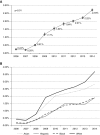Trends and Racial Disparities of Palliative Care Use among Hospitalized Patients with ESKD on Dialysis
- PMID: 31387926
- PMCID: PMC6727267
- DOI: 10.1681/ASN.2018121256
Trends and Racial Disparities of Palliative Care Use among Hospitalized Patients with ESKD on Dialysis
Abstract
Background: Study findings show that although palliative care decreases symptom burden, it is still underused in patients with ESKD. Little is known about disparity in use of palliative care services in such patients in the inpatient setting.
Methods: To investigate the use of palliative care consultation in patients with ESKD in the inpatient setting, we conducted a retrospective cohort study using the National Inpatient Sample from 2006 to 2014 to identify admitted patients with ESKD requiring maintenance dialysis. We compared palliative care use among minority groups (black, Hispanic, and Asian) and white patients, adjusting for patient and hospital variables.
Results: We identified 5,230,865 hospitalizations of such patients from 2006 through 2014, of which 76,659 (1.5%) involved palliative care. The palliative care referral rate increased significantly, from 0.24% in 2006 to 2.70% in 2014 (P<0.01). Black and Hispanic patients were significantly less likely than white patients to receive palliative care services (adjusted odds ratio [aOR], 0.72; 95% confidence interval [95% CI], 0.61 to 0.84, P<0.01 for blacks and aOR, 0.46; 95% CI, 0.30 to 0.68, P<0.01 for Hispanics). These disparities spanned across all hospital subtypes, including those with higher proportions of minorities. Minority patients with lower socioeconomic status (lower level of income and nonprivate health insurance) were also less likely to receive palliative care.
Conclusions: Despite a clear increase during the study period in provision of palliative care for inpatients with ESKD, significant racial disparities occurred and persisted across all hospital subtypes. Further investigation into causes of racial and ethnic disparities is necessary to improve access to palliative care services for the vulnerable ESKD population.
Keywords: ESKD; dialysis; disparity; ethnic minority; palliative care; race.
Copyright © 2019 by the American Society of Nephrology.
Figures



Comment in
-
Another Example of Race Disparities in the US Healthcare System.J Am Soc Nephrol. 2019 Sep;30(9):1553-1554. doi: 10.1681/ASN.2019070700. Epub 2019 Aug 6. J Am Soc Nephrol. 2019. PMID: 31471499 Free PMC article. No abstract available.
References
-
- United States Renal Data System : 2017 USRDS Annual Data Report: Epidemiology of Kidney Disease in the United States, Bethesda, MD, National Institutes of Health, National Institute of Diabetes and Digestive and Kidney Diseases, 2017
-
- Chan HW, Clayton PA, McDonald SP, Agar JWM, Jose MD: Risk factors for dialysis withdrawal: An analysis of the Australia and New Zealand Dialysis and Transplant (ANZDATA) registry, 1999-2008. Clin J Am Soc Nephrol 7: 775–781, 2012 - PubMed
-
- Davison SN, Jhangri GS, Johnson JA: Cross-sectional validity of a modified Edmonton symptom assessment system in dialysis patients: A simple assessment of symptom burden. Kidney Int 69: 1621–1625, 2006 - PubMed
-
- Yong DS, Kwok AO, Wong DM, Suen MH, Chen WT, Tse DM: Symptom burden and quality of life in end-stage renal disease: A study of 179 patients on dialysis and palliative care. Palliat Med 23: 111–119, 2009 - PubMed
-
- Flythe JE, Hilliard T, Lumby E, Castillo G, Orazi J, Abdel-Rahman EM, et al. .: Kidney Health Initiative Prioritizing Symptoms of ESRD Patients for Developing Therapeutic Interventions Stakeholder Meeting Participants : Fostering innovation in symptom management among hemodialysis patients: Paths forward for insomnia, muscle cramps, and fatigue. Clin J Am Soc Nephrol 14: 150–160, 2019 - PMC - PubMed
Publication types
MeSH terms
Grants and funding
LinkOut - more resources
Full Text Sources
Medical

